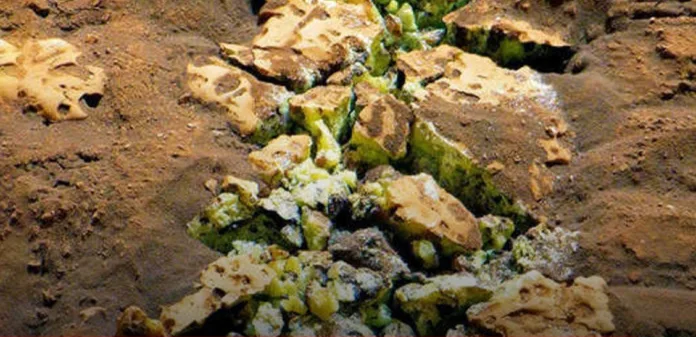The discovery of yellow sulfur crystals on Mars by NASA’s Curiosity Rover raises questions about the planet’s geological history and suggests more exciting finds might be on the horizon.
NASA‘s Curiosity rover, exploring the Martian surface, has made an astonishing discovery: a field of bright yellow sulfur crystals embedded in a rock. This surprising find occurred when the rover’s wheels cracked open a rock, revealing the crystals inside.
The revelation has left scientists at NASA both amazed and curious. Ashwin Vasavada, Curiosity’s project scientist, remarked, “Finding a field of stones made of pure sulfur is like finding an oasis in the desert. It shouldn’t be there, so now we have to explain it.” The unexpected nature of the discovery challenges existing theories about Mars’ geological and environmental conditions.
Curiosity, which has been operational on Mars since 2012, was specifically analyzing Mount Sharp within the Gale Crater during this latest mission. The crater, situated in the central region of Gale, has been a focal point for studying Mars’ past environments and climatic conditions. Recent soil analyses from Mount Sharp revealed high levels of sulfates, hinting at the potential presence of sulfur crystals in the area.
The discovery of these crystals is significant because sulfur is typically associated with volcanic activity or mineral-rich water evaporation. The presence of sulfur on Mars raises intriguing questions about the planet’s volcanic history and whether it experienced significant geothermal activity in the past. This finding could also provide new insights into Mars’ environmental conditions and the processes that shaped its surface.
In addition to the sulfur crystals, Curiosity’s exploration of Gediz Vallis—a channel on Mars—uncovered evidence of water flow. The rover detected signs of erosion and sediment deposition, indicating that water once cut through the soil in this region. This further supports the hypothesis that Mars had liquid water in its past, which could have made the planet more hospitable.
The discovery of sulfur crystals and evidence of past water flow highlights Mars’ dynamic geological history. Becky Williams, deputy principal investigator of Curiosity’s Mast Camera and a scientist with the Planetary Science Institute, commented, “This was not a quiet period on Mars. We’re looking at multiple flows down the channel, including energetic floods and boulder-rich flows.” Her remarks underscore the significance of these findings in understanding Mars’ evolving landscape.
Analysis:
Political:
The discovery of sulfur crystals on Mars could impact political decisions related to space exploration and funding. Governments and space agencies may increase their investment in Mars missions to explore the implications of these findings further. The unexpected nature of the discovery may also bolster arguments for continued support of space exploration programs, highlighting the potential for groundbreaking scientific discoveries.
The new information might also influence international collaborations in space research. Countries with space programs could see the discovery as an opportunity to join forces in future missions to Mars, fostering international cooperation in space exploration and research.
Social:
The discovery of sulfur crystals and evidence of water flow on Mars captures public imagination and reinforces the value of space exploration. It provides a tangible example of how scientific missions can yield unexpected and significant results. This event may inspire a new generation of scientists and space enthusiasts, encouraging more interest in STEM fields and scientific careers.
The finding also stimulates discussions about the potential for life on Mars. As scientists continue to explore and analyze these discoveries, they could fuel societal debates about the possibility of life beyond Earth and humanity’s future in space.
Racial:
While the discovery itself does not directly address racial issues, it highlights the contributions of diverse scientists involved in the Mars mission. Promoting the achievements of scientists from various backgrounds can encourage greater diversity in the scientific community and inspire individuals from underrepresented groups to pursue careers in STEM fields.
Gender:
The involvement of female scientists like Becky Williams in this discovery emphasizes the importance of gender diversity in science. Highlighting the contributions of women in space exploration can encourage more women to enter and advance in STEM careers, helping to address gender disparities in the field.
The discovery may also lead to increased support for initiatives aimed at promoting gender equality in science and technology. By showcasing the achievements of female scientists, the space community can foster a more inclusive environment and inspire future generations of women scientists.
Economic:
The discovery of sulfur crystals and evidence of water flow on Mars could have significant economic implications. Increased interest in Mars exploration may lead to greater investment in space technologies and research. This investment could stimulate growth in the space industry, create new job opportunities, and drive innovation in planetary science.
Additionally, the findings could impact industries related to space travel and habitation. As scientists explore the possibility of future human missions to Mars, there could be economic benefits related to the development of life-support systems, space habitats, and other technologies necessary for long-term space exploration.
